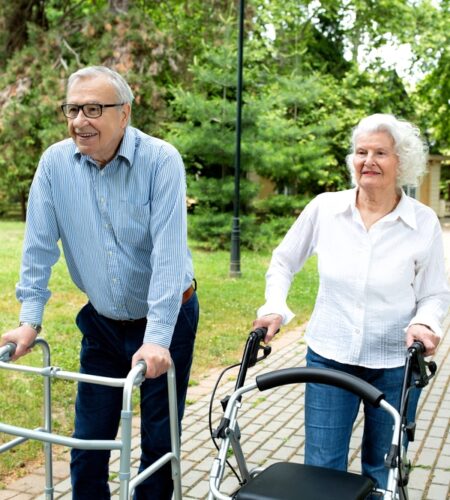In an era where technology touches every aspect of life, it has also revolutionized the world of mobility aids for seniors. Tech-enabled walking aids are redefining independence for the senior, offering enhanced safety, functionality, and adaptability. These advanced devices go beyond traditional walking aids, incorporating cutting-edge technology to meet the varied mobility needs of seniors.

Tech-enabled walking aids come in various forms, including smart canes, walkers, and even exoskeletons, each designed to assist seniors in different ways. Smart canes, for example, are equipped with sensors that can detect obstacles, changes in terrain, or even unusual movements that may indicate a fall. Some models are integrated with GPS navigation, providing guidance and location tracking, which is especially helpful for seniors with memory issues.
Advanced walkers are another category of tech-enabled aids, offering features such as automatic braking systems, lights for visibility, and even foldability for easy transport. These walkers are designed to provide stable support and can be adjusted to different terrains, making them suitable for both indoor and outdoor use. The integration of smart technology allows for monitoring and alerts, which can be connected to a smartphone app, keeping family members informed about the user’s safety and whereabouts.


Exoskeletons represent the cutting edge of walking aids. Though more sophisticated and less common, they offer substantial support for mobility. These wearable devices can assist with lifting, standing, and walking, providing strength and stability to the lower body. Exoskeletons are particularly beneficial for seniors with significant mobility impairments, offering them a level of independence that was previously unattainable.
One of the key benefits of tech-enabled walking aids is their focus on fall prevention. Falls are a major concern for the senior, often leading to serious injuries. Smart walking aids are designed to reduce this risk by enhancing stability and providing alerts if a fall is detected. Features like automatic locking mechanisms, balance support, and real-time monitoring add an extra layer of security for users.
The ergonomic design of these devices is also a critical aspect. They are created with the understanding that senior users require comfortable, easy-to-use aids. Ergonomic handles, adjustable heights, and lightweight materials are standard features, ensuring that the walking aids are as comfortable as they are functional.
In addition to physical support, tech-enabled walking aids offer psychological benefits. They provide seniors with a sense of safety and confidence, knowing that they have a reliable support system. This confidence can lead to increased activity levels, better overall health, and a more engaged lifestyle.
Conclusion
In conclusion, tech-enabled walking aids are transforming the way seniors approach mobility challenges. By blending advanced technology with ergonomic design, these devices offer seniors a safer, more independent way of life. As technology continues to evolve, we can expect even more innovative solutions to enhance the mobility and quality of life for the senior population.



Comments